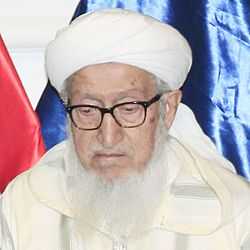Sibghatullah Mojaddedi
| Sibghatullah Mojaddedi صبغت الله مجددی | |
|---|---|
 | |
| Mojaddedi in September 2014 | |
| President of Afghanistan | |
| In office 28 April 1992 – 28 June 1992 | |
| Prime Minister | Abdul Sabur Farid Kuhestani |
| Preceded by | Abdul Rahim Hatef (Acting) |
| Succeeded by | Burhanuddin Rabbani |
| Personal details | |
| Born | 1926 (age 88–89) Afghanistan |
| Political party | Afghan National Liberation Front |
| Religion | Sunni Islam |
Sibghatullah Mojaddedi (Pashto صبغت الله مجددي, born c. 1926) is a politician in Afghanistan, who served as Interim President after the fall of Mohammad Najibullah's government in April 1992. He is also the founder of the Afghan National Liberation Front, and served as the chairman of the 2003 loya jirga that approved Afghanistan's new constitution. In 2005 he was appointed chairman of the Meshrano Jirga, upper house of the National Assembly of Afghanistan, and was reappointed as a member in 2011. He also serves on the Afghan High Peace Council.
Early years
Mojaddedi was born between 1925 and 1929 in Afghanistan.[1][2][3] His family, the Mojaddedis, are a well-known family of religious scholars from Kabul[4] who trace their descendancy to Mujaddid Ahmad Sirhindi, a prominent 16th-century Islamic scholar and Naqshbandi Sufi.[2][3] Ethnically, the Mojaddedis are categorized as Pashtuns.[5][6]
Mojaddedi studied Islamic Law and Jurisprudence at al-Azhar University in Cairo, Egypt. In 1952 he returned to Afghanistan to teach in high schools and at Kabul University, where he became known as an advocate of Afghan independence.[2][3]
In 1959, Mojaddedi was accused of conspiring against then Soviet Prime Minister Nikita Khrushchev and was imprisoned until 1964.[2] He spent many of the following years, including the period of Taliban rule, in exile in several countries such as Denmark and Pakistan before his entry into Afghan politics.[2][3]
Politics
Mojaddedi is considered a moderate Muslim leader.[7] He is a member of the Jebh-e-Nejat-e Melli (National Liberation Front).[6]
In 1989, the Afghan Interim Government appointed him as the president of the country.[8] In 1992, he was the chair of the Islamic Jihad Council that was set up to establish a post-Soviet Afghan government.[7] This position lasted three months, although some sources say he stayed for only two months.[7][9] In May 1992, Burhanuddin Rabbani established a new leadership council. This council undermined Mojaddedi's leadership, resulting in his resignation and handing over power to a new council.[7][9] During this time in 1992, when Mojaddedi was President of Afghanistan, the Ariana plane carrying him to Kabul was hit by an RPG as it was landing at Kabul International Airport. The plane landed safely, with no fatalities.[10][11]
After the fall of the Taliban in 2001, Mojaddedi returned to Afghanistan from Pakistan and became chairman of the Loya Jirga, the assembly which approved Afghanistan's new constitution. In 2005, he became chairman of the Meshrano Jirga, Afghanistan's upper house of the National Assembly of Afghanistan, and he was reappointed as member in 2011.[2] He also serves on the Afghan High Peace Council.[12]
Two suicide bombers carried out an attack in Kabul on 12 March 2006 against Mojaddedi, while he was a member of the upper house and head of a reconciliation committee aimed at engaging former Taliban members.[13] The attackers blew up a vehicle filled with explosives next to his car as he was being driven through the streets.[14] Four pedestrians were killed and Mojaddedi was slightly injured, with burns to his face and hands.[13]
References
- ↑ Amstutz, Bruce (1994). Afghanistan: The First Five Years of Soviet Occupation. DIANE Publishing. p. 406. ISBN 0-7881-1111-6. Retrieved 2013-07-20.
Born in 1925, he completed high school in Kabul and then went to Al-Azhar University in Cairo to earn Bachelor's and Master's degrees in Islamic law and Jurisprudence.
- ↑ 2.0 2.1 2.2 2.3 2.4 2.5 Afghan Bios (14 April 2012). "Who is Who in Afghanistan: Mojadedi, Sibghatullah Hazrat Sahib Mujadidi Mojadidi". Retrieved 30 December 2012.
- ↑ 3.0 3.1 3.2 3.3 Safis Web (24 Sep 2006). "Profile: Sibghatullah Mojaddedi". Retrieved 30 December 2012.
- ↑ Stedman & Tanner 2002, p. 70
- ↑ Eide, Kai (2012). Power Struggle Over Afghanistan: An Inside Look at What Went Wrong-And What We Can Do to Repair the Damage. Skyhorse Publishing Inc.,. p. Chapter Three. ISBN 1-6160-8464-2. Retrieved 2013-07-20.
Eighty-year-old Mojadeddi, a Pashtun, had been Karzai's mentor during the mujahideen times and was a deeply respected and moderate politician.
- ↑ 6.0 6.1 Eur 2003, p. 94
- ↑ 7.0 7.1 7.2 7.3 Gladstone 2001, p. 8
- ↑ Eur 2003, p. 65
- ↑ 9.0 9.1 Runion 2007, p. 116
- ↑ Aviation Safety Net
- ↑ Human Rights Watch report
- ↑ Kumar Sen, Ashish (28 September 2010). "Afghan ‘peace council’ draws fire". Washington Times. Retrieved 30 December 2012.
- ↑ 13.0 13.1 Human Rights Watch 2007, p. 40
- ↑ Radio Free Europe
Bibliography
- Eur (2003). Far East and Australasia 2003. Routledge. ISBN 1-85743-133-2.
- Gladstone, Gary (2001). Afghanistan: History, Issues, Bibliography. Novinka Books. ISBN 1-56033-105-4.
- Human Rights Watch (April 2007). "AFGHANISTAN The Human Cost The Consequences of Insurgent Attacks in Afghanistan" 19 (6c). Human Rights Watch.
- Runion, Meredith L (2007). The history of Afghanistan. Greenwood Press. ISBN 978-0-313-33798-7. OCLC 237144347.
- Stedman, Stephen John; Tanner, Fred (2002). Refugee manipulation : war, politics, and the abuse of human suffering. Brookings Institution Press. ISBN 0-8157-8090-7. OCLC 123336516.
External links
| Wikimedia Commons has media related to Sibghatullah Mojaddedi. |
- Biography of Sibghatullah Mojaddedi
- Afghanistan National Independent Peace and Reconciliation Commission
| Political offices | ||
|---|---|---|
| Preceded by Abdul Rahim Hatef Acting |
President of Afghanistan Acting 1992 |
Succeeded by Burhanuddin Rabbani |
| ||||||||||||||||||||||